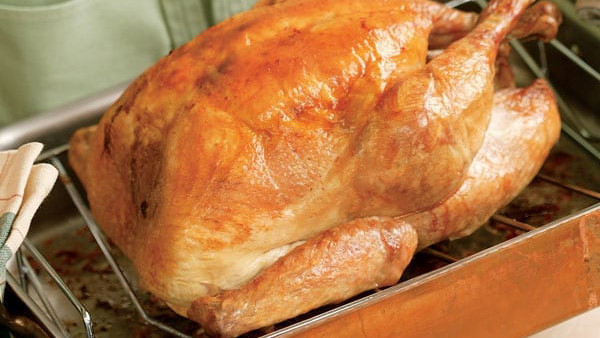
Brining a Turkey
Share
Brining has become a popular method for preparing turkey, especially during the holiday season, and it’s a technique that goes beyond just the big bird. Brining helps enhance flavor and adds moisture. We love brined pork loin roast.
Brining a turkey or a pork loin is perfect anytime of year. Make Father's Day festive with a brined smoked pork loin.
Why Brine Your Turkey?
At its core, brining is a method of soaking meat in a saltwater solution, which allows the meat to absorb additional moisture. During cooking, meats naturally lose moisture, but brining helps counteract that effect by adding a buffer. Brined turkey is much less likely to dry out, making it perfect for long roasting times and holiday meals where moist, flavorful turkey is the goal.
Another advantage is the boost in flavor. Brine solutions often contain herbs, spices, and sometimes even a touch of sweetness from ingredients like sugar or honey. This infusion adds depth to the meat, so each bite is both juicy and bursting with flavor. Even simple saltwater brines can significantly enhance the taste, while more complex brine recipes allow you to experiment and customize the flavor to suit your preferences.
Types of Brines
There are a couple of ways to brine a turkey: wet brining and dry brining.
Wet Brining
The traditional method is wet brining, which involves submerging the turkey in a large container filled with a brine solution. The basic recipe usually includes water, salt, and sugar, but you can add herbs (like rosemary, thyme, and sage), spices (such as peppercorns and bay leaves), citrus zest, garlic, and more for an extra flavor kick. Wet brining generally requires a large container and enough refrigerator space to keep the bird cool, as it typically needs to sit in the brine for at least 24 hours up to 3 days.
This is exactly how we brine in this recipe. We use Big Tom’s Roasting Rub and Brine spices as our herbs, spices, and sugar. We add salt.
Dry Brining
Dry brining is a bit simpler and doesn’t require extra fridge space or a large tub. This technique involves rubbing salt and any desired seasonings directly onto the turkey and allowing it to rest uncovered in the refrigerator. Dry brining still draws moisture to the meat’s surface, which dissolves the salt and allows it to penetrate the meat. After several hours to overnight, you’ll get that same juicy, flavorful outcome without the need for water. Plus, dry-brined turkeys tend to have crisper skin, which is a big bonus for many.
What Else Can You Brine?
Turkey may be the main star when it comes to brining, but other foods can benefit from the process too! Pork chops and pork loin can also be brined to enhance flavor and juiciness.
To see how to do this method check out this youtube video.
Brining a turkey with Big Tom's spices
Rated 5.0 stars by 1 users
Category
Turkey and Poultry
Cuisine
American
Author:
Sauce Goddess
This recipe has brining options for starting with a frozen or fresh turkey.

Ingredients
- 1 gallon of water
-
½ cup Sauce Goddess Big Tom's Roasting Rub and Brine spices
-
¼ cup kosher salt
- Cooler (taller is best with just enough to fit the turkey tightly and have some room for ice)
- Thermometer (refrigerator thermometer)
-
Lid items- a Cookie sheet, glass baking pan, plastic cutting board or plastic storage container that fits inside the cooler flat, anything water-proof and heavy to weight down the turkey
-
Combine all ingredients in cooler big enough to fit the turkey tightly and a good amount of ice, but don’t add the ice yet. If the turkey is too big you'll need more water and the brine solution will be diluted. If it’s too small you won’t have room for ice as needed to keep the bird safely at 41°.
Directions
- Frozen Turkey-3-4 DAY brine
- !Day One
Remove the outer packaging from your frozen turkey. We are going to brine this while it thaws, It’s the perfect answer for the space a big turkey takes up in your fridge while it’s thawing.
- Place your frozen turkey unwrapped into your cooler with the brine bath.
- Yes, the packages of giblets and goodies are still inside we remove those in a couple of days.
- If there is not enough water, add only enough to cover the turkey. It all depends on the size of your cooler
Place the lid item on top of the turkey.
- Place your heavy object on top of the lid.
- The turkey should be completely submerged in ice cold brine water from its own frozen state.
- Place thermometer in on top of everything. Close the cooler.
Day 2- Check the cooler. Everything should still be under the brine and completely frozen. If it is not covered, adjust the weight to make sure the turkey stays down below the liquid. Temperature should be 41°.
Day 3- We will check the cooler twice from here on out.
AM-Check the cooler. If the cooler isn’t 41 degrees, you will need to add ice. Remove your ‚Äúlid‚Äù. By this time the turkey should be feeling just a barely soft on the outside but may still be frozen for the most part. Add ice if needed. Replace the lid and weight.
- PM- Remove lid and weight. Now carefully flip the turkey over. See how loose the legs are and if you can get the bag of goodies and the neck out of the cavity. Check temp and add ice.
Day 4 or 5-AM-open cooler and check temp. If you didn’t remove the items from the cavity yesterday it should be ready today. Remove everything from inside the body and neck area. Add lots of ice.
- PM- add more ice and turn the turkey over. Everything should be thawed by now and really nicely brined.
If you have a really big bird, then you‚Äôll need an extra day to finish the thaw. Otherwise if your turkey is completely thawed at this point you can remove it and place it in your fridge or add more ice to keep it 41° until you’re ready to cook.
If you have a fresh turkey, do a 24 hour brine. Food safety is critical since the only thing keeping your turkey cold is ice. You will need a larger cooler for the extra ice. The fridge is easier for a fresh turkey but there still may be an issue with space.
Day 1- AM-Mix the brine as listed. Place turkey in cooler with brine.
- Place 5 lbs. of ice into a zip top baggie. This allows us to chill the brine and turkey without diluting the brine itself.
- Place ice bag in the cooler.
- Cover etc. as listed above.
Day 1- Late PM-Remove old baggie of ice (now water) and add new bag of ice.
Day 2- AM- Remove from the brine and you’re ready to roast, smoke or deep fry that turkey.
- Pat the turkey completely dry inside and out.
Rub Big Tom’s seasoning on the outside, in the cavity and under the skin on the breast.
I like to cook my turkey upside down. It’s not as pretty on the platter but the breast meat cannot get dried out unless it’s is very very overcooked.
Cook until the thigh meat measures 165 on the thermometer.
Recipe Note
Frozen turkey will be up to 5 days, no more. With a fresh turkey you can brine as little as one day. Don't go for longer than 3 days.
Read this entire recipe carefully before starting the process.

